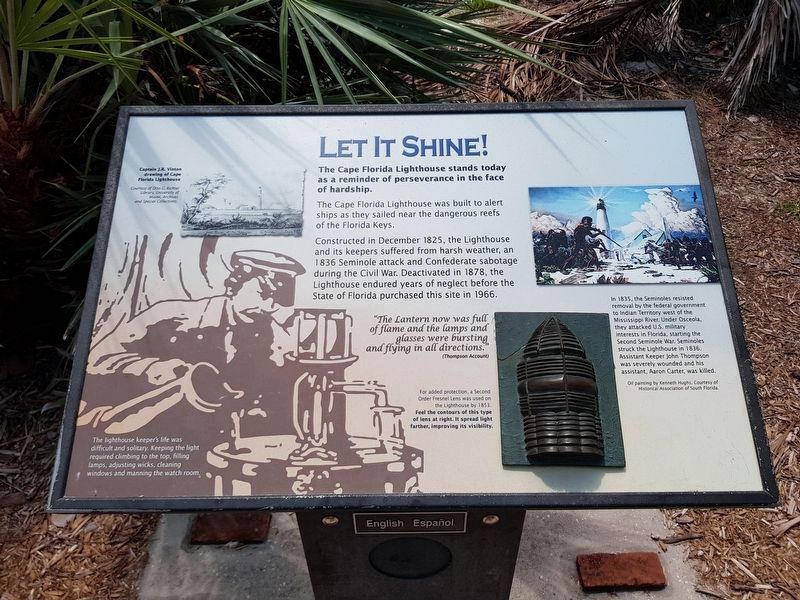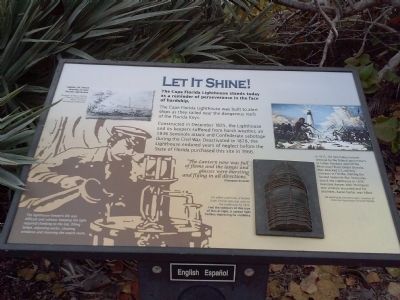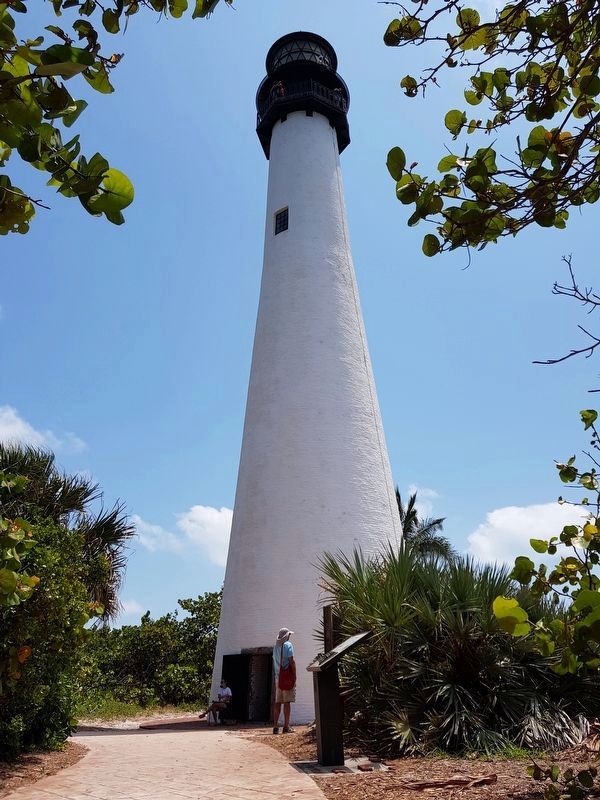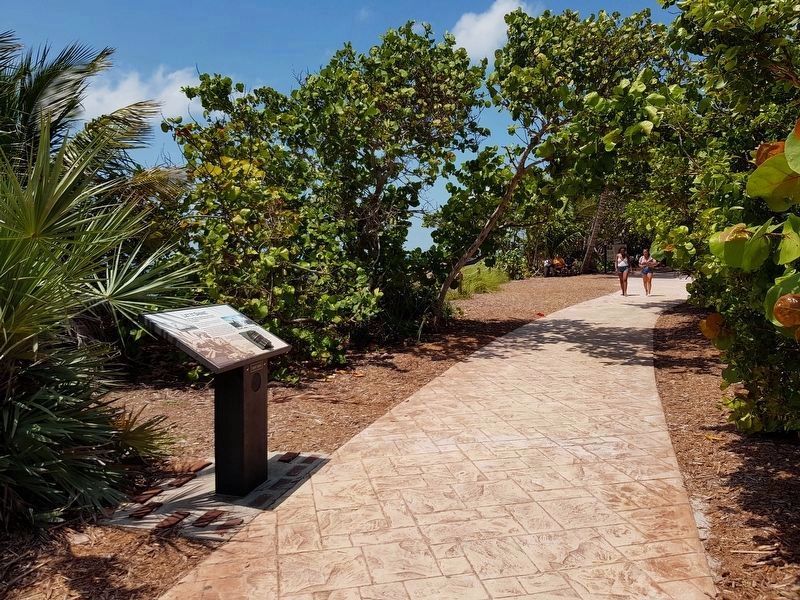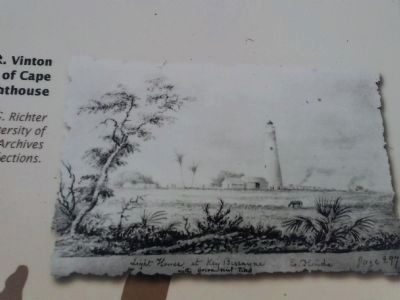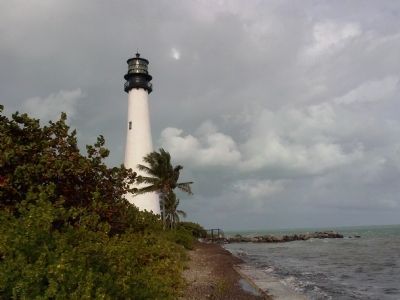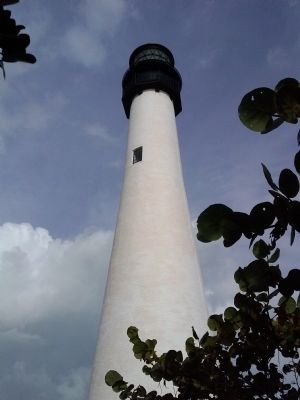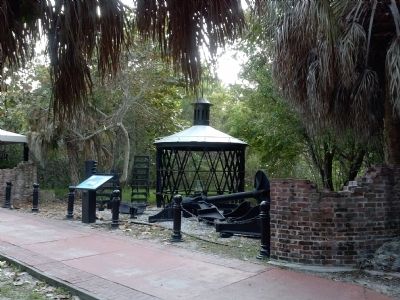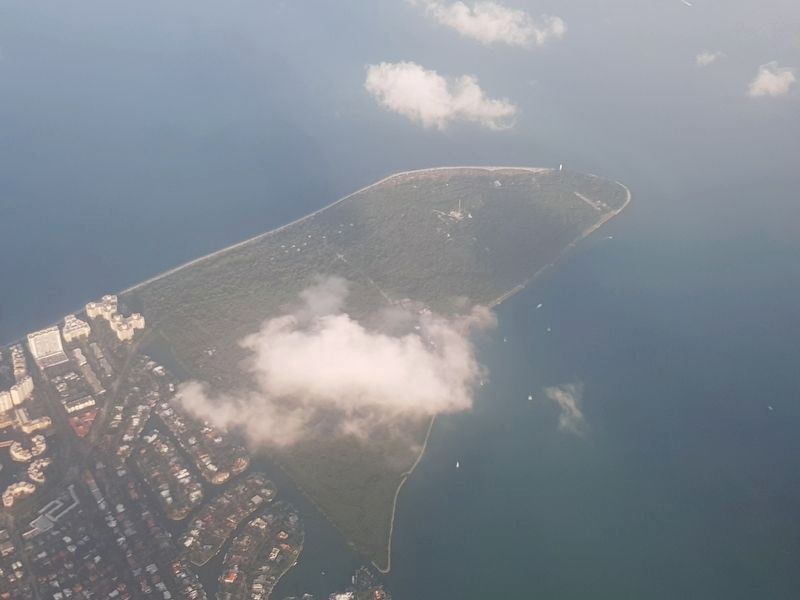Key Biscayne in Miami-Dade County, Florida — The American South (South Atlantic)
Let It Shine!
The Cape Florida Lighthouse was built to alert ships as they sailed near the dangerous reefs of the Florida Keys.
Constructed in December 1825, the Lighthouse and its keepers suffered from harsh weather, an 1836 Seminole attack and Confederate sabotage during the Civil War. Deactivated in 1878, the Lighthouse endured years of neglect before the State of Florida purchased this site in 1966.
"The Lantern now was full of flame and the lamps and glasses were bursting and flying in all directions." (Thompson Account)
(captions)
(upper left) Captain J.R. Vinton drawing of Cape Florida Lighthouse Courtesy of Otto C. Richter Library, University of Miami Archives and Special Collections
(lower left) The lighthouse keeper's life was difficult and solitary. Keeping the light required climbing to the top, filling lamps, adjusting wicks, cleaning windows and manning the watch room.
(lower right) For added protection, a Second Order Fresnel Lens was used on the Lighthouse in 1853. Feel the contours of this type of lens at right. It spread light farther, improving its visibility.
Erected by Florida Department of Environmental Protection, Division of Recreation and Parks.
Topics and series. This historical marker is listed in these topic lists: Wars, US Indian • Waterways & Vessels. In addition, it is included in the Lighthouses series list. A significant historical month for this entry is December 1825.
Location. 25° 39.993′ N, 80° 9.363′ W. Marker is in Key Biscayne, Florida, in Miami-Dade County. Marker can be reached from the intersection of Cape Florida Park Boulevard and South Crandon Boulevard, on the left when traveling south. The marker is located near the Cape Florida Lighthouse in Bill Baggs Cape Florida State Park. Touch for map. Marker is at or near this postal address: 1200 S Crandon Blvd, Key Biscayne FL 33149, United States of America. Touch for directions.
Other nearby markers. At least 8 other markers are within walking distance of this marker. Escaping to Freedom in the Bahamas (within shouting distance of this marker); Lighthouse Keeper's Cottage (within shouting distance of this marker); The Archaeology of Key Biscayne (within shouting distance of this marker); U.S. Coast Survey Base Marker (within shouting distance of this marker); Key Biscayne, The Barrier Island (about 300 feet away, measured in a direct line); Dade Heritage Trust’s Cape Florida Lighthouse Brick Program (about 300 feet away); Restoration Hardware (about 400 feet away); The Bahama Dinghy (about 400 feet away). Touch for a list and map of all markers in Key Biscayne.
Regarding Let It Shine!. Ponce de Leon named this area "Cape of Florida" when he led the first Spanish expedition to Florida in 1513. The Cape Florida lighthouse, the park's best known feature, was completed in 1825 but was damaged during the Second Seminole War. The repaired tower, completed in 1846, remains the oldest standing structure in Miami-Dade County.
The island served as a secret meeting place and port for runaway slaves and Black Seminoles waiting to rendezvous with sea captains or board dugouts for a passage to safety in the British Bahamas. Although the lighthouse was built to save lives and ships, its unflinching light brought an end to this evenue of escape. In September 2004, Cape Florida was designated a National Underground Railroad Network to Freedom Site. (from the Florida State Parks brochure)
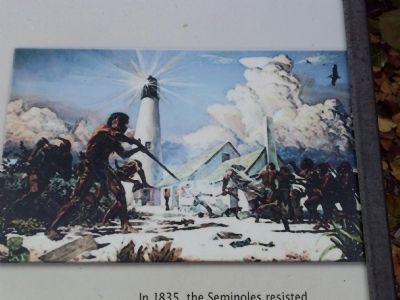
Photographed By Marsha A. Matson, December 2, 2014
5. Hughs painting on marker
In 1835, the Seminoles resisted removal by the federal government to Indian Territory west of the Mississippi River. Under Osceola, they attacked U.S. military interests in Florida, starting the Second Seminole War. Seminoles struck the Lighthouse in 1836. Assistant Keeper John Thompson was severely wounded and his assistant, Aaron Carter, was killed. Oil painting by Kenneth Hughs, Courtesy of Historical Association of South Florida.
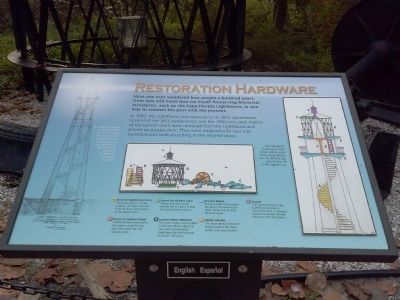
Photographed By Marsha A. Matson, December 2, 2014
9. Restoration hardware marker
Have you ever wondered how people a hundred years from now will know how we lived? Preserving historical structures, such as the Cape Florida Lighthouse, is one way to connect the past with the present.
In 1996, the Lighthouse was restored to its 1855 appearance. Several of the 1855 components and the 1960s-era steel replica of the lantern room were removed from the Lighthouse and placed on display here. They were replaced with cast iron reproductions built according to the original plans.

Photographed By Marsha A. Matson, December 2, 2014
12. Cause for Conservation marker
"The wild unspoiled beauty of Cape Florida - 510 acres of pines, palms, and beach at the tip of Key Biscayne - has long been hailed...as a natural park and nature reserve."
"Eight years ago, The Miami News urged it to be bought for this purpose from the owner, Mrs. Elena Santeiro Garcia...and has continued over the years to campaign on the grounds that the eventual alternative will be development..."
"Now the owner...has revealed she would favorably entertain an offer of $8.6 million. One way or another, a decision seems near on the future of one of Florida's last untouched tracts." Bill Baggs, May 23, 1965, The Miami News.
But the people also need parks, room to recline, to listen to the soft drawl of a place to dock a small boat or simply a place to walk. Bill Baggs, June 27, 1965.
Bill Baggs: As editor of the Miami News from 1957-1969, Bill Baggs used his column to champion the preservation of Cape Florida. Mrs. Garcia's decision to sell her property to the state paved the way for this park.
Before the State of Florida purchased the land, there were plans to develop it. Feel the difference between the development plans (left) and how the park looks today (right).
Credits. This page was last revised on August 21, 2019. It was originally submitted on December 17, 2014, by Marsha A. Matson of Palmetto Bay, Florida. This page has been viewed 711 times since then and 54 times this year. Photos: 1. submitted on May 26, 2019, by J. Makali Bruton of Accra, Ghana. 2. submitted on December 17, 2014, by Marsha A. Matson of Palmetto Bay, Florida. 3, 4. submitted on May 26, 2019, by J. Makali Bruton of Accra, Ghana. 5, 6, 7, 8, 9, 10, 11, 12. submitted on December 17, 2014, by Marsha A. Matson of Palmetto Bay, Florida. 13. submitted on August 21, 2019, by J. Makali Bruton of Accra, Ghana. • Bernard Fisher was the editor who published this page.
